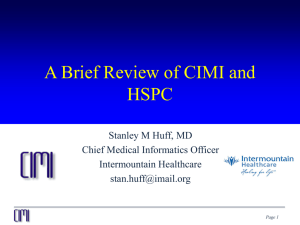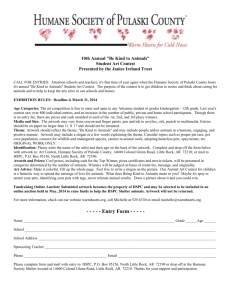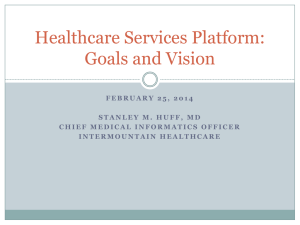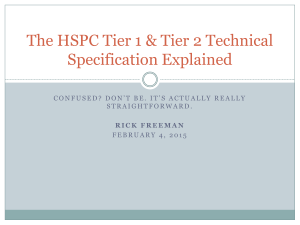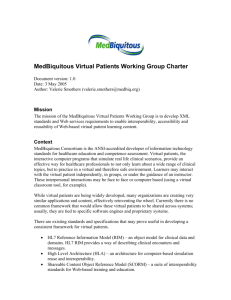HSPC Washington 150618 Stan Huff
advertisement
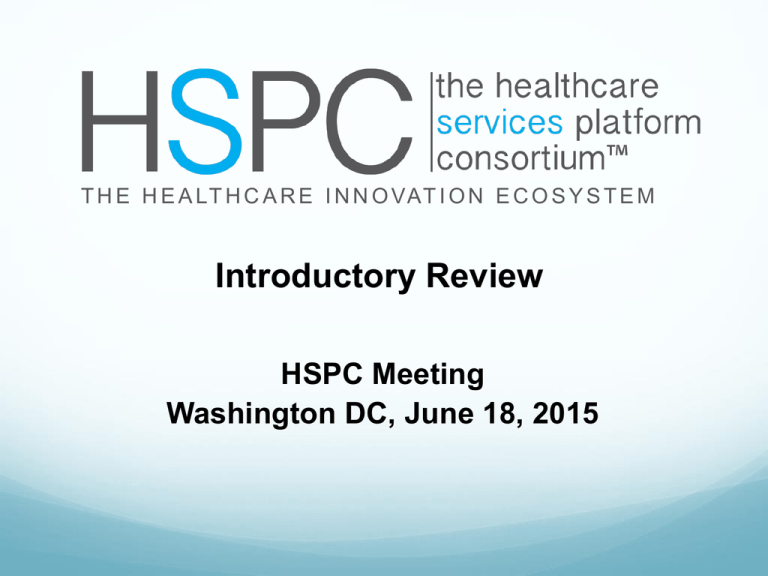
T H E H E A LT H C A R E I N N O VAT I O N E C O S Y S T E M Introductory Review HSPC Meeting Washington DC, June 18, 2015 Contact Information Stanley M. Huff, MD Chief Medical Informatics Officer Intermountain Transformation Laboratory 5022 South State Street Murray, UT 84107 Office: 801.507.9111 | Cell: 801.573.6470 Fax: 801.507.9400 | stan.huff@imail.org 2 Agenda Why the Health Care Services Platform Consortium? HSPC – functions and principles Organizational structure Key relationships with other organizations The vision of the future Goals for this meeting 3 Why HSPC? Homer Warner and HELP Intermountain can only provide the highest quality, lowest cost health care with the use of advanced clinical decision support systems integrated into frontline clinical workflow Dr. Homer Warner 5 Decision Support Modules Antibiotic Assistant Diabetic care Ventilator weaning Pre-op antibiotics ARDS protocols ICU glucose protocols Nosocomial infection Ventilator disconnect monitoring MRSA monitoring and control Prevention of Deep Venous Thrombosis Infectious disease reporting to public health Infusion pump errors Lab alerts Blood ordering Order sets Patient worksheets Post MI discharge meds 6 Strategic Goal Be able to share data, applications, reports, alerts, protocols, data entry screens, and decision support modules with anyone Goal is “plug-n-play” interoperability 7 FHIR Profiles from CIMI Models (uing standard terminology) Heterogeneous Systems Commercial EHR Home Grown System System Integrator Others… Characteristics of a new Ecosystem Consistent and unambiguous data collection Data stored and accessed through truly semantically interoperable services Sharing of data for direct patient care, population based analytics, and research Sharing of applications, executable clinical decision support and knowledge 9 What Is Needed to Enable a New Ecosystem? Standard set of detailed clinical data models coupled with… Standard coded terminology (SNOMED CT, LOINC, RxNorm, others) Standard query language Standard API’s (Application Programmer Interfaces) for healthcare related services Open sharing of models, coded terms, and API’s Sharing of decision logic and applications 10 HSPC Functions and Principles Essential Functions of the Consortium Select the standards for interoperable services Standards for models, terminology, security, authorization, context sharing, transport protocols, etc. Modeling: SNOMED, LOINC, RxNorm – FHIR Profiles – do it together Publish the models, and development instructions openly, licensed free-for-use Provide testing, conformance evaluation, and certification of software Gold Standard Reference Architecture and its Implementation We will work with an established company to provide this service Fees that off set the cost of certification will be charged to those who certify their software Implementation of the standard services by vendors against their database and infrastructure Everyone does not have to do every service There must be a core set of services that enable a marketplace 12 Other Functions of the Consortium Participation in “other” functions is optional for a given member Enable development “sandboxes” Could be provided by companies or universities Could be open source or for-profit Set up an actual “App Store” Many companies already have their own app stores Vendor certification that a given application can be safely used in their system Accommodate small companies or individuals that won’t have their own app store Create a business framework to support collaborative development Pre-agree on IP, ownership, co-investment, allocation of revenue Try to avoid unique contracts for each development project Provide a way for people to invest (Venture capital) 13 Other Functions – for discussion Needs Reference implementation (for testing and certification) Sand boxes – to speed development SOA Define and implement a technology stack Platform architecture Proposal – Form a Technical Committee to define scope and make a work plan 14 Principles Not-for-profit entity There could be an associated for-profit entity some day Provider led Simple majority of providers on the Board of Directors All organizations will have equal influence and opportunity Intermountain and LSU will not be “special” Start small, be effective, and then grow We want to allow everyone that is interested to participate Allow diverse strategies and participants Open source and for-profit One person business up to multi-national corporations Healthcare providers and healthcare software developers Students and professional software engineers 15 Principles (continued) Initially, focus on the minimum set of standards and technology Increase options as we gain experience and success HSPC is not producing software (mostly) HSPC members or groups of members produce software HSPC will need to provide a reference implementation for purposes of certification No “central planning” by HSPC of app development Participants decide what they want to build and invest their own resources We DO need to agree about the minimum set of services that will enable a marketplace 16 Organizational Structure Healthcare Services Platform Consortium Organizational Chart Advisory Committees Board of Directors Secretary Non Voting Non Voting Technical Steering Committee CFO Marketing Membership Voting CEO Business Development General Counsel Support CTO Voluntary Board Advisory Committees and TSC and Technical Committees Advisory Committees Membership Finance Technical Steering Committee Marketing Tier I Architecture Tier II Architecture Sandbox Modeling and Terminology Organizational Guiding Principles Board of Directors (BOD) Selected by Benefactor Members Each Benefactor Member can elect one board seat for every 200K contribution to HSPC May be elected in the event that the Board seats exceed seven BOD members Serve a 3 year term at the pleasure of the benefactor members Strategic role – the Board does not manage day-to-day activities Board Level Advisory Committees Serve to advise on strategy at the pleasure of the board Voluntary Chairs appointed by the BOD Chairs can come from operational staff or at large To vote must be Associate Members or higher Technical Committees Report to the Technical Steering Committee, which reports to the Board One vote per membership CTO is an ex-officio member of the TSC Leadership of TCs elected by the members of the TC (benefactor and associate members) Operations Responsible for execution under the direction of the CEO Follow strategic objectives set by the BOD Disputes will be resolved by the HSPC BOD Key Organizational Relationships (not exhaustive) CIMI (Clinical Information Modeling Initiative) HSPC will use CIMI models for creation of implementable models including detailed HL7 FHIR profiles CIMI plans to become a part of HL7 HL7 HSPC will use HL7 FHIR for data services CIMI plans to become a part of HL7 HSPC will use HL7 as the forum for creating industry wide agreement about: Detailed profiles for true interoperability Consensus of professional and clinical bodies about data that needs to be collected and shared (workflow or process interoperability) Joint CIMI and HL7 FHIR Meeting • Meetings will be hosted by Intermountain Healthcare in Salt Lake City, August 10-11 • Everyone is invited! • Aug 10: Technical meeting: laying out a course for CIMI to write profiles/clinical models • Aug 11: Clinical meeting: creating broad consensus on profiles for true interoperability SMART HSPC will use SMART as a EHR integration strategy HSPC will work together with SMART on all activities of mutual interest We will create a written document (MOU?) to describe the relationship between the two organizations Center for Medical Interoperability Work for support of CIMI and HSPC as part of C4MI technical programs Possible activities Host a vendor and provider neutral app store Create a reference implementation of HSPC services Host a development sandbox Logistic support Meetings, websites, publicity Host a model repository (and other knowledge artifacts) Support online terminology services Tool development Conformance testing and certification National Library of Medicine Proposed: A public repository and distribution center for CIMI/HSPC developed value sets (VSAC) Argonauts Don’t know for sure A call is planned to discuss the relationship Work together on HIMSS demonstrations? Work together to create industry wide consensus for profiles to be used for “true” interoperability? Vision for the Future Like Google Maps… Apps that address specific focused problems… Provider-facing services App 1 App 2 Focused decision support Visualization Disease management Specialty workflows National Shared Services Genomic testing & CDS Pharmacogenomic screening CDC Ebola screening? CDC immunization forecaster Prior Authorization / Appropriateness EHR App 3 Like Facebook… Apps that enable data sharing… App 1 Next-gen Interoperability Population Health integration HIE integration Data capture for research Clinical Trial recruiting Quality Repositories EHR 1 EHR 2 EHR 3 Like ???? … Apps that empower patients / consumers… Apps as Prescriptions SMART Phone App Chronic disease management Pt-Provider Communication Remote monitoring Outcome capture & Clinical Effectiveness Monitoring EHR Pop Health HSPC Internet Sites Wiki: https://healthservices.atlassian.net/wiki/display/HSPC/ Healthcare+Services+Platform+Consortium Website: http://hspconsortium.org/#/ 33 Goals For This Meeting Review use cases Document the use cases Make specific plans for development and implementation Make plans to integrate FHIM and VA modeling and terminology efforts Determine how we can work together Initiate a platform technical committee? Initiate a testing and certification technical committee? Create an initial roadmap for activities for the next 6 months Q&A Appendix OUR MISSION Improve health by creating a vibrant, open ecosystem of interoperable applications. OUR VISION Be a provider-led organization that accelerates the delivery of innovative healthcare applications that improve health and healthcare. HSPC History HSPC was incorporated as a not-for-profit corporation on August 22, 2014 Meetings May 2013 Salt Lake City August 2013 in Phoenix January 2014 Salt Lake City May 2014 in Phoenix July 2014 Salt Lake (Technical modeling meeting) August 21-22 2014, Washington DC, hosted by IBM February 4-6, New Orleans, Louisiana, hosted by LSU June 17-19, Washington DC 39 OUR GOAL Our goal is to create an open marketplace featuring the industry’s first vendor-neutral Healthcare App Store and to foster a vibrant entrepreneurial community to deliver the best solutions quickly, easily and seamlessly to improve the quality of today’s accountable care. Achieving the gold standard of true semantic interoperability, our services platform seeks to dramatically augment today’s standards efforts by providing a ground-breaking collaborative platform and real world laboratory to advance the native interoperability of healthcare applications. ABOUT HSPC The Healthcare Services Platform Consortium (HSPC) is a provider-driven organization of leading healthcare organizations, IT vendors, systems integrators, and venture firms dedicated to unlocking the power of entrepreneurial innovation to improve healthcare outcomes. Through HSPC’s open marketplace and services platform, we seek to foster a new level of providervendor collaboration and innovation to meet one of the industries’ greatest needs -- accelerating the creation, sharing and delivery of promising software applications at the point of care. OUR MEMBERS HSPC’s founding members are established leaders in shaping the course of healthcare. Intermountain Healthcare Department of Veterans Affairs LSU Health Regenstrief Institute Harris Corporation They are joined by a growing membership of forward thinking providers, vendors, technology providers, researchers and venture firms, all committed to creating a new and open, market-based paradigm to drive innovation at the point of patient care. HOW WE’LL DO IT Collaborate with members to create a specification (based on existing industry standards where possible) Truly semantically interoperable data access specification Security standard for clinical applications and data access. Authorization, Authentication, Application Launch Context, etc. Clinical Care Pathways Coordinated Care across multiple providers Proactively seek new members Provide a development sandbox representative of a real world hospital system. Host an App Store
